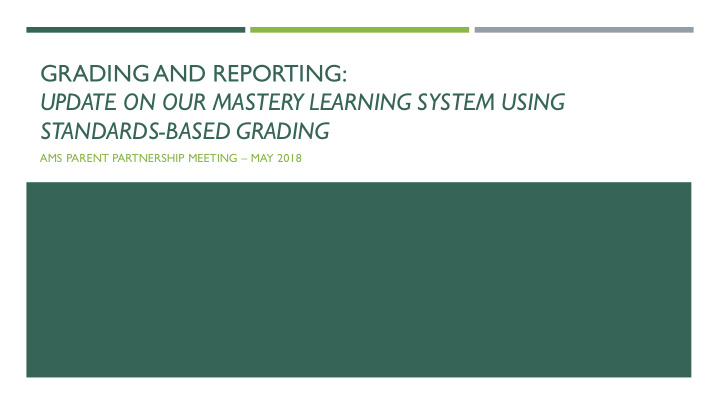



GRADING AND REPORTING: UPDATE ON OUR MASTERY LEARNING SYSTEM USING STANDARDS-BASED GRADING AMS PARENT PARTNERSHIP MEETING – MAY 2018
WHY STANDARDS BASED GRADING? Growth mindset Quality curriculum and assessment Clear communication Equity of experience for students (consistency) Student motivation and involvement
STANDARDS BASED GRADING VIDEO
TRADITIONAL VERSUS STANDARDS-BASED Traditional Grading System Standards-Based Grading System Based on assessment methods (quizzes, tests, Based on learning goals and performance standards. homework, projects, etc.). One grade/entry is given per One grade/entry is given per learning goal. assessment. Standards are criterion or proficiency-based. Criteria Assessments are based on a percentage system. and targets are made available to students ahead of Criteria for success may be unclear. time. Use an uncertain mix of assessment, achievement, Measures achievement only OR separates achievement effort, and behavior to determine the final grade. May from effort/behavior. No penalties or extra credit given. use late penalties and extra credit. Everything goes in the grade book – regardless of Selected assessments (tests, quizzes, projects, etc.) are purpose. used for grading purposes. Include every score, regardless of when it was collected. Emphasize the most recent evidence of learning when Assessments record the average – not the best – work. grading. Adapted from O’Connor K (2002). How to Grade for Learning: Linking grades to standards (2nd ed.). Thousand Oaks, CA: Corwin Press.
WHAT IS A COMPETENCY? Larger than a standard (made up of multiple standards) Reflects applied skills and knowledge Used to assess and report out on learning
EXAMPLE COMPETENCY – GRADE 5 GEOMETRY Geometry Competency : Students will solve problems involving reasoning using properties of 2- and 3- dimensional shapes to analyze, represent, and model geometric relationships in authentic applied contexts. Standards that relate to this competency: Use a pair of perpendicular number lines, called axes, to define a coordinate system, with the intersection of the lines (the origin) arranged to coincide with the 0 on each line and a given point in the plane located by using an ordered pair of numbers, called its coordinates. Understand that the first number indicates how far to travel from the origin in the direction of one axis, and the second number indicates how far to travel in the direction of the second axis, with the convention that the names of the two axes and the coordinates correspond (e.g., x -axis and x -coordinate, y -axis and y -coordinate). Represent real world and mathematical problems by graphing points in the first quadrant of the coordinate plane, and interpret coordinate values of points in the context of the situation. Understand that attributes belonging to a category of two-dimensional figures also belong to all subcategories of that category. For example, all rectangles have four right angles and squares are rectangles, so all squares have four right angles. Classify two-dimensional figures in a hierarchy based on properties.
GRADE 6 LITERACY STANDARDS AND COMPETENCIES
Level 1 Assessment Descriptors 2 Score Extending 4 The student consistently and independently demonstrates the ability to analyze and synthesize essential content, knowledge, and skills in a new task. Student demonstrates an in-depth, extensive, or comprehensive knowledge of content. Student communication is complex, concise, and sophisticated with thorough support, explicit examples, evaluations and justifications. Student uses and consistently implements a variety of appropriate strategies. Meeting 3 The student consistently and independently demonstrates the ability to apply and transfer Standard essential content, knowledge, and skills in a new task. Student demonstrates a broad content knowledge. Student communication is accurate, clear, and organized with relevant details and evidence. Student uses appropriate strategies to solve problems and make decisions. Approaching 2 The student demonstrates the ability to comprehend and apply essential content, knowledge, and Standard skills in a familiar task. Student communicates reasonably well but draws weak conclusions or only partially solves or describes. Student attempts appropriate strategies with limited success. Beginning 1 The student is not demonstrating the application and transfer of essential content, knowledge, and Standard skills.
REPORT CARDS AND PROGRESS REPORTS Rolling Grades - All grades are rolling until the end of the course - Students continue to demonstrate evidence of their learning and earn scores throughout the course Honor Roll – one time per year, at end of year, working with SAU 39-wide committee to determine levels National Junior Honor Society – working within charter of NJHS to determine our cut score Report cards and progress reports – seeking feedback
RESOURCES One School Street - Mastery Based Learning and Grading https://oneschoolstreet.org/mastery-based-learning-and-grading/ New England Secondary School Consortium - Proficiency Based Transcripts https://www.newenglandssc.org/resources/college-admissions/ What is a 21 st Century Education – Smithsonian Student Travel https://www.youtube.com/watch?v=Ax5cNlutAys The Future of Learning – 2 Revolutions https://www.youtube.com/watch?v=xoSJ3_dZcm8
APPENDIX
Future of Jobs Report, World Economic Forum
K-12 COMPETENCY EDUCATION / MASTERY LEARNING STATE POLICY ACROSS THE US
75 NEW ENGLAND INSTITUTIONS OF HIGHER EDUCATION STATE THAT PROFICIENCY -BASED DIPLOMAS DO NOT DISADVANTAGE APPLICANTS
75 New England institutions of higher education state that proficiency-based diplomas do not disadvantage applicants How Selective Colleges and Universities Evaluate Proficiency-Based High School Transcripts: Insights for Students and Schools
EXAMPLE TRANSCRIPT http://greatschoolspart nership.org/wp- content/uploads/2016/ 11/Exemplar-HS- Transcript.pdf
Recommend
More recommend